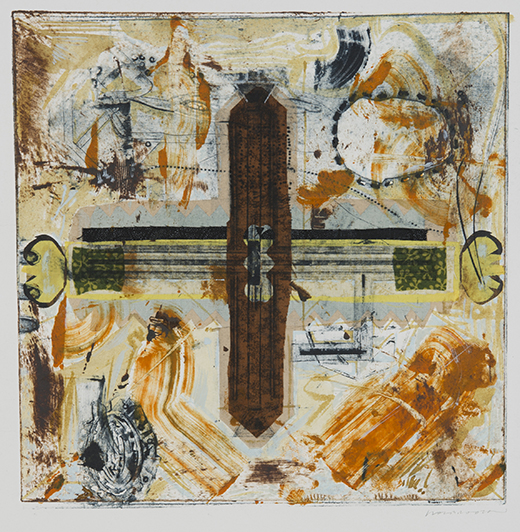
This Chris Holbrook collagraph print shows the artist’s use of ink, graphite, colored pencils and chine colle.
Chris Holbrook is a printmaker by discipline and a homespun expressionist. He has formal and conceptual affiliations with the Chicago Imagist School as well as other regional artists known for idiosyncratic narratives infused with a decidedly Midwestern funk and philosophy. His work is quasi-DaDaist — conceptually dark but tinged with humor and enabled with exceptionally inventive draftsmanship. He moves with ease from folk figuration to ultra-textured planar abstraction.
Some passages in Chris’ work are facsimiles of drawing and printmaking conventions across inland America. He has inherited a sensitivity to form and narration present in the works of regional artists like David Driesbach, Karen Kunc, Lloyd Menard, David Becker, Tony Fitzpatrick and Suellen Rocca, fiercely independent artists who toy with primitivism. The obsessively noirish oeuvres of east coast artists like Robert E. Marx and Leonard Baskin have also influenced him but his assemblage compositions are his own delightfully dislocated and fragmented speech. His work abounds with outsider art symbolism — rife with creatures formed from ritual afflictions and indulgences. Like the above artists, he personalizes a fundamental visual core of early modernism — a Picasso-esque flare for interpreting progressive art language in normative theatrical formats. Vernacular portraits and claustrophobic spaces are rendered in tragi-comic flair.
The artists mentioned above have a connection apart from any stylistic or methodological similarity. Their work, like Chris’ work, has been fully formed, theorized and vetted in a culture outside the dominant, and exclusionary, coastal art-market. Its significance lies in part that it is radically connected to anecdotal impressions of rural, small town and suburban Americana — finely tuned into extraordinarily independent works that extinguish the flames of Midwestern provincialism. To be sure, the academy has made a home for much of this innovative work. There is a hierarchy of practitioners, many now professor emeriti who have held court and populated Big Ten university art collections for decades. Chris is an heir, tethered, like so many formidable alumni, to the university culture of cities like Madison, Iowa City, Lincoln, Neb., Bloomington Ind., Vermillion S.D., Knoxville, Tenn., DeKalb, Ill. and Peoria. Their art provides cultural distinction and history to their communities –- a paucity dependent on evolutionary cycles that have lasted as long as the coastal mono-culture that assumes the Modernism’s legacy.
Holbrook also obsesses over cryptic abstractions — byzantine, game-filled anti-narratives. Their logic can be deceptively simple or unresolvable, trembling under their own mass, or scurrying back in the shadows of cubes, columns and cruciforms. Structures are imagined, erased, forgotten, re-membered, and then re-designed on a circular path to an initial idea or image. His collagraphs employ a graphic process that relentlessly investigates, re-adjusts and re-stages imagery with ink, graphite, colored pencils and chine colle to make incredibly dense monotypes. They’re just as consuming as his narrative work and viewers still have to unravel their softer logic.
Holbrook recently was confronted with a health crisis that demanded his complete attention, and it culminated with a positive, self-researched medical intervention. His productivity had to be re-focused on surviving and now he’s poised to get back in the studio. When asked if his now manageable condition might change his work he replied that mortality, whether expressed in parody or dread, had been a standard part of this repertory for some time. Now we have the pleasure of watching him replenish his interrupted world/project/imagination.

1 comment for “”